As I write this post, I am looking down at my mostly black mouse pad, which is emblazoned with stars, rippling U.S. flags, and a large emblem of the Harley-Davidson motorcycle company.
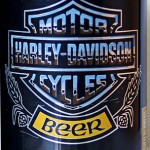
Pabst, a maker of beers appealing to the blue-collar crowd, brewed one under the Harley name for awhile. (mcwont, Flickr Creative Commons)
And to my right is a photo of my four kids, taken on a day when they visited VOA some years ago. It’s encased in a black picture frame on which a different Harley logo — this one winged and pewter — appears.
By the look of it all, you’d think I was a big-time biker, a “real bad mamma jamma,” as the Geico insurance company’s smooth-talking lizard puts it in a commercial pitching motorcycle insurance.
Well, not exactly. In fact, I’ve ridden on a motorcycle only two or three times in my life — and, then on the back, clinging fiercely to one unfortunate person or another.
The Harley accents in my office came courtesy of my son, Rob, from the time he worked at a Harley-Davidson outlet store on the Delaware shore. It seems that Harley-Davidson has become such an iconic brand, almost synonymous with motorcycling and an entire vroom-vroom culture, that it sells millions of dollars of goods — from dice to men’s hats (oh, I have one of those with the Harley eagle, too) — that have nothing directly to do with motorcycles at all.
I learned the power and reach of this brand several years ago on a visit to the Midwest farm state of Wisconsin. There, you’ll find thousands and thousands of hogs. Not just four-legged swine, but also steel and chrome Harley motorcycles that riders affectionately call “Hogs” – the only motorcycles still mass-produced in the United States. Wisconsin’s largest city – Milwaukee – is home to the Harley-Davidson Motor Company and an entire Harley culture.
Freedom. Adventure. Pavement. Leather. Chrome. These are some of the words that spring to the screen when you open the Harley-Davidson Motor Company’s Web page. The company boldly asserts – and most owners agree – that a Harley is more than a machine that goes fast. It’s a way of life.
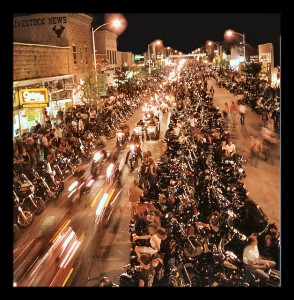
See what I mean when I say bikers take over little Sturgis? (christopher.d.heald, Flickr Creative Commons)
That’s true of all large, loud motorcycles, of course. I think of their rebel image, dating to Marlon Brando’s portrayal of the leader of a motorcycle gang in the 1953 film “The Wild One,” in which he rides a Triumph Thunderbird. And of the annual gathering of thousands of motorcyclists, who have pretty much taken over the little South Dakota town of Sturgis every August for the past 71 years — and will do so again this year.
But it’s my impression that Harleys are a breed apart. And lots of the folks who ride Hogs look nothing like the image that some people have of bikers as “bad mamma jammas:” bearded, tattooed Hell’s Angels gang-member types. In New Berlin, Wisconsin, I ran into Randy Martin, a 52-year-old, clean-shaven, conservatively dressed brewery employee who had just traded in his ’96 Hog for a new, solid-black Harley with lots of chrome.
“Once you get the bike, you have to get all the motor clothes that go with it,” he told me. “And it’s fun, ‘cause there’s always new things comin’ out. It’s like your own personal trademark that says something about your personality.”
Like what? I asked him
“I want to look macho on the bike. I want to blend in with the rest of the bikers. And I enjoy the total experience.”
As he looked around Hal’s Harley dealership in New Berlin, Randy had his pick of jackets, gloves, T-shirts, jewelry, golf balls, knives, stuffed animals, picture frames (like mine), beer steins – even fish hooks – all imprinted with the trademark orange, black, and white Harley-Davidson logo.
You can even buy Harley-Davidson coffee.
Hal’s general manager, Kirk Topel, told me he had been racing Harleys since he was 16. His office looked down on six rows of new Harleys, the largest of which cost $25,000 and came with a wrap-around fiberglass windshield, cruise-control acceleration, and a communications system that connects driver and passenger.
It weighed more than 350 kilos. We’re talking motorcycle, remember.
“There are very few modes of transportation where you become a part of the country that you travel through,” Kirk said to me. “The freedom of just being able to turn a wrist and accelerate, with the wind in your hair [never mind our helmet laws], and the breeze in your face, and feeling the warmth of the sun on your skin…”
I could almost feel it. And I could faintly hear the strains of a country song by Turner Nichols called “Harleys and Horses.”
It’s Harleys and Horses
Old habits that are forcing me to think
I may never change my ways.
In fact, Harley-Davidson’s company historian, Martin Jack Rosenblum — who’s also a biker poet and a recording artist in his own right — told me that horses and Harleys had been paired since the company’s founding in 1903.
“Think about the era. [Western frontier marshal] Wyatt Earp was still alive. He died in 1929. It was still the spirit of the Old West. The archetypal cowboy on horse, these were still around. And I believe that there was a transfer from horse to motorcycle in the nation’s imagination.”
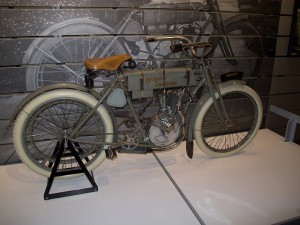
A Harley that debuted only four years after the company began. Looks like it puttered more than vroomed. (Ed Bierman, Flickr Creative Commons)
Martin Jack Rosenblum oversees the company’s collection of thousands of artifacts – including Harley’s first production cycle, built by William T. Harley and three Davidson Brothers. He says Harleys have been called “hogs” since the 1920s, when a rider carried the Harley racing team’s pet pig astride his gas tank on victory laps. And Rosenblum, a self-described romantic, told me that one lure of a Harley is rebelliousness — the desire to be unique.
It’s a shamanistic sensibility that when you get this motorcycle, it transforms you. You transform it. Each rider personalizes his or her motorcycle to such an extent that it really becomes a folk art rolling sculpture. Whoever you dream yourself to be, you will make your bike into. You are saying, “Leave me alone. I’m just doing what I want to do.”
Sort of a Bob Seger “runnin’ against the wind” thing.
Against the wind
I’m still runnin’ against the wind
I’m older now but still runnin’ against the wind
Visitors can tour Harley’s production facility in Milwaukee and watch engines being tested. Each day, one is randomly yanked off the assembly line and placed on a machine called a “dyno” that performs several tests over 10 hours. Then the engine is completely disassembled to check for wear.
Tour guide Michelle Fox told me each person on the assembly line has exactly 3 minutes, 17 seconds to perform a function before the line moves. Operators know the maximum time is drawing near when warning bells sound.
Talk about stress in the workplace! How would you like a bell or siren to go off in your ear just before the moment you promised to deliver a memo, or a minute before you assured someone you’d return a phone call?
The people on the Harley line also had — and probably still have — a red button that they can press in case of emergency. Do so, and the entire line shuts down.
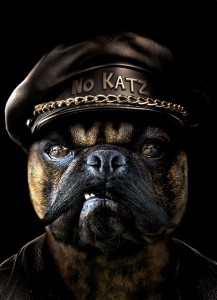
Had to give a dog equal time with that cat. I think I passed this guy out in Nebraska. (AZRainman, Flickr Creative Commons)
The Harley-Davidson Motor Company does not just build new Harleys. It also still makes parts to fit cycles going as far back as a 1916 model that uses a kick-start pedal. Some of the company’s workers worldwide take old cycles and perform what is called “remanufacturing” – installing new parts, sprucing up the finish, and adding accents like custom pinstriping.
Each Harley tells a story, but each owner has hundreds of them.
So do motorcylists in general. We’ve had quite a few bikers here at VOA. [Interruption: “bikers” generally ride motorcycles; some are even in gangs. If bicycles are your ride, you’re a “cyclist.” I know, some cyclists call themselves bikers, but where are the tattoos and scraggly hair?] Back to my biker colleagues: they include a couple that has tooled about together, on the same bike, for 30 years. They, and the other motorcyclists here, are a hardy bunch, riding to and from work, and all over America, in all seasons, in all weather.
And always, in a manner of speaking, with the top down.
Which brings me to my big closing number! Four biker quotes — whose authors have ridden down the road by now without introducing themselves — that capture the essence of their machine-driven lifestyle:
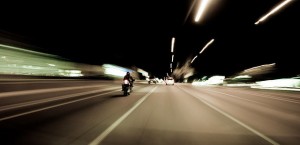
You're one with the road on a motorcycle. One with it for sure if your cycle crashes. (Omer Wazir, Flickr Creative Commons)
• “I’d rather be riding my motorcycle thinking about God than sitting in church thinking about my motorcycle.”
• “Four wheels move the body. Two wheels move the soul.”
• “The best alarm clock is sunshine on chrome.”
• And, thinking of my VOA colleagues, “If you don’t ride in the rain, you don’t ride.”
Ted's Wild Words
These are a few words from this posting that you may not know. Each time, I'll tell you a little about them and also place them into a cumulative archive of "Ted's Wild Words" in the right-hand column of the home page. Just click on it there, and if there's another word that you'd like me to explain, just ask!
Archetypal. Something or someone that is the recognized example, or symbol, of a genre or motif. The Empire State Building in New York, for instance, is the archetypal skyscraper.
Dyno. A dynamometer, which is a device that measures an engine’s power and torque.


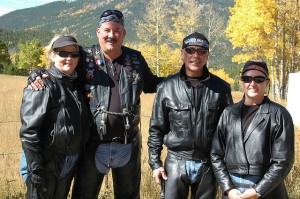
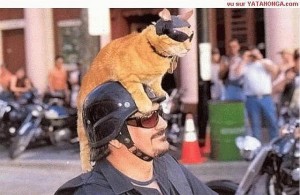

4 responses to “Hog Culture”
I was maybe a sophomore in high school the only time I’ve been on something with two wheels propelled by a motor. It was a motor scooter that I rode it into the side of a passing car. That was it for me.
What a load of crap. The writer acts as though this band of faux-barbarians lives in world apart from the world of normal people with reasonable expectations of reasonable quiet. Now that every middle-aged man in America with self-image issues needs a Harley to “look macho”, it is no longer possible to separate one’s self from the deafening roar of this pathetic and loud special-interest group. Everywhere, anywhere, anytime. Even our National Parks are nothing more than playgrounds self-centered creeps. While these miscreant members of the Cult of Harley-Davidson are busy living out their silly retrograde fantasy, the rest of us are having our lives degraded by their illegal noise. Yes, illegal. The writer should have done some research regarding the law before waxing so poetically on the subject of this silly “lifestyle”.
Dear Papa Juliet,
A colorful but cogent response. I didn’t feel I was glorifying the motorcycle lifestyle, but maybe I was. I’m not the least bit interested in squeezing into a leather outfit and annoying my neighbors by riding around suburban Washington myself, but I find those who do interesting. Keep reading and responding. Thanks.
Ted
I can’t stand the stupidity of people claiming “rugged individualism” or “buy American” when it comes to Harleys.If they were a modern design,I could see the nationalism;but they are a 1930s-era throwback and perform as such.Plus,they are very expensive!As for the uniqueness of ownership,please!Everywhere you look,there are fat people wearing the Harley costume acting all superior.I can’t tell you how many times I’ve been looked down upon when getting gas for my Italian sport bike.I didn’t buy it to pose,I bought it for it’s performance,beauty,and style.If I wanted to join a club,I’d join the NRA.Not join a bunch of posers drinking and riding from bar to bar…